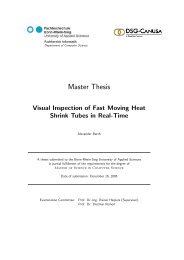Master Thesis - Hochschule Bonn-Rhein-Sieg
Master Thesis - Hochschule Bonn-Rhein-Sieg
Master Thesis - Hochschule Bonn-Rhein-Sieg
You also want an ePaper? Increase the reach of your titles
YUMPU automatically turns print PDFs into web optimized ePapers that Google loves.
4. Overall evading concept <strong>Master</strong> <strong>Thesis</strong> Björn Ostermann page 45 of 126<br />
a) b)<br />
Figure 26: Detected intrusion a) before targeting and<br />
b) after targeting the robot base<br />
virtual<br />
robot<br />
base<br />
The calculation of the reachable space results in the flexible fence as displayed in Figure 27b. The<br />
computations start with the data of the intrusion detection (Figure 24) including the virtual robot base.<br />
Upon this data a region growing algorithm is executed (see chapter 5.2.4.1). The remaining noise is<br />
eliminated by a size filter (see chapter 5.2.4.2). Then the flexible fence, depicted as a blue line, is<br />
computed (see chapter 5.5.3). The resulting vectors of the blue line are transmitted to the data<br />
exchange object (see chapter 4.6) to be later used in the path planning control thread (see chapter 4.4).<br />
The next subpart is the calculation of distance between the robot and intruding objects, for the<br />
implemented approach control. It can be activated by button 10, which automatically deactivates the<br />
reachable space calculation. The resulting image of this subpart is displayed as shown in Figure 27c.<br />
The green area shows the robot, surrounded by (green) distance lines which automatically extend<br />
around the robot’s area, until they touch the nearest (red) intruding object. To achieve this image,<br />
again the data of the intrusion detection (Figure 24) containing the virtual robot base is used. As<br />
before, regions are grown, identified and filtered. The region identified as the robot is taken by the<br />
algorithm described in chapter 5.4, which creates the distance lines by uniformly enlarging the taken<br />
area, until one intruding region is touched. The steps of this algorithm are counted and transmitted to<br />
the data exchange object (see chapter 4.6) to be later used in the path planning control thread (see<br />
chapter 4.4), which controls the robot’s speed according to the distance.














